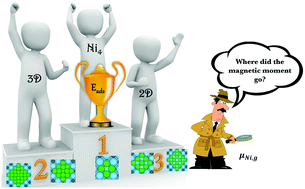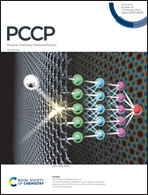Structural, electronic, and magnetic properties of Ni nanoparticles supported on the TiC(001) surface†
Abstract
Metals supported on transition metal carbides are known to exhibit good catalytic activity and selectivity, which is interpreted in terms of electron polarization induced by the support. In the present work we go one step further and investigate the effect that a titanium carbide (TiC) support has on the structural, electronic, and magnetic properties of a series of Ni nanoparticles of increasing size exhibiting a two- or three-dimensional morphology. The obtained results show that three-dimensional nanoparticles are more stable and easier to form than their homologous two-dimensional counterparts. Also, comparison to previous results indicates that, when used as the support, transition metal carbides have a marked different chemical activity with respect to oxides. The analysis of the magnetic moments of the supported nanoparticles evidences a considerable quenching of the magnetic moment that affects mainly the Ni atoms in close contact with the TiC substrate indicating that these atoms are likely to be responsible for the catalytic activity reported for these systems. The analysis of the electronic structure reveals the existence of chemical interactions between the Ni nanoparticles and the TiC support, even if the net charge transfer between both systems is negligible.

- This article is part of the themed collection: 2020 PCCP HOT Articles


 Please wait while we load your content...
Please wait while we load your content...
